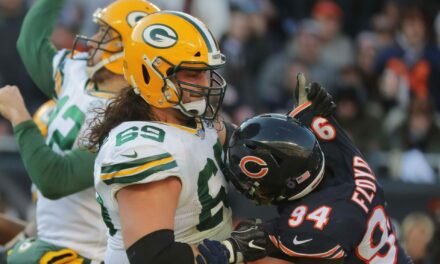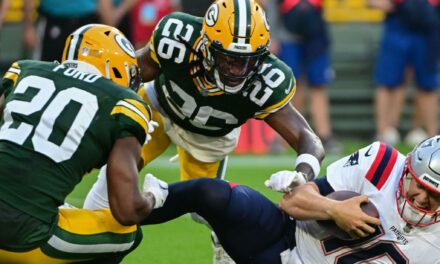It’s not too common that teams have two picks in the first round of the NFL Draft. In the 50-plus drafts since the NFL/AFL merger was finalized in 1970, the Green Bay Packers have had more than one pick in the first round of the draft just nine times. But entering the 2022 NFL Draft, the Packers hold the 22nd and 28th picks in the first round and have two picks in the second round as well.
So, how have the Packers done when they’ve had two first-round picks? Here’s a look back the nine times the Packers have had two picks in the first round since 1970. This includes only times the Packers have ultimately used two first round picks in one draft. If they originally had two picks but traded one away, that is not included here.
2019: OLB Rashan Gary, 12th, S Darnell Savage, 21st
Both players have developed into quality starters. Gary has improved each season and led the Packers with 9.5 sacks last year. He has consistently gotten pressure on opposing quarterbacks and has elite athletic ability and a strong work ethic.
Savage has looked outstanding at times but has struggled with consistency. He has eight interceptions through three NFL seasons and teams with Adrian Amos to give the Packers two solid starters at safety.
2009: DT B.J. Raji, 9th, OLB Clay Matthews, 26th
Raji and Matthews both became Pro Bowlers and both had magic moments that led to the Packers winning their last Super Bowl after the 2010 season.
Raji had a pick-six in the NFC Championship Game against the Bears that helped the Packers defeat the Bears 21-14. He played six seasons for the Packers and was a starter in five of them. Raji made the Pro Bowl after the 2011 campaign and had a career-high 6.5 sacks in 2010.
Matthews had an immediate impact on defense and became one of the better pass rushers in Packers history. Matthews forced a fumble in the fourth quarter of Super Bowl XLV which was a key play in the Packers victory over the Steelers.
He made six Pro Bowls and was All Pro once while accumulating 83.5 sacks in 10 seasons with the Packers. That total may have been even higher had he not moved to ILB in 2015 when injuries struck the team.
1993: OLB Wayne Simmons 15th, S George Teague 29th
Simmons spent five seasons with the Packers and was a solid starter at OLB during the team’s Super Bowl-winning 1996 season. He specialized in covering tight ends and used his speed effectively in that role. He tragically died in a car crash at the age of 32 in 2002.
Teague spent three productive years with the Packers before spending five seasons with Dallas and one with Miami. He started immediately as a rookie and intercepted six passes in three seasons with the Pack.
His biggest moment came in the Packers 28-24 playoff win over the Lions after the 1993 season when he returned an interception 101 yards for a touchdown. That proved to be the turning point of the game.
1990 DE/OLB Tony Bennett 18th, RB Darrell Thompson, 19th
In 1990, the Packers had back-to-back first-round picks, holding the 18th and 19th overall selections. With the 18th pick, the Packers took DE/OLB Tony Bennett who spent four seasons with the Packers and provided a solid pass rush when he was healthy. In 1991 he had 13 sacks and followed that up with 13.5 in 1992.
He spent four seasons with the Colts from 1994-1997 to round out his NFL career.
Thompson played five seasons with the Packers but never lived up to the potential he showed at the University of Minnesota. His best season came in 1993 when he led the Packers with a career-high 654 yards rushing and scored three rushing touchdowns.
He finished his NFL and Packers career with 1,641 yards rushing and an average of 3.5-yards per carry.
1980 DT Bruce Clark 4th, ILB George Cumby 26th
While the Packers had two first-round picks in this year’s draft, only one of the players they selected ever played in Green Bay. Bruce Clark told the Packers before the draft that he didn’t want to play for the Pack but the Packers selected him anyway and he quickly signed with Toronto of the Canadian Football League. The Packers traded his rights to the Saints and he made the Pro Bowl playing for New Orleans in 1984.
Cumby was a quick but undersized linebacker who spent six seasons with the Packers including four as a starter. He finished his career with a season in Buffalo and one game with the Eagles. He combined with John Anderson, Mike Douglass and Rich Wingo to give the Packers a solid linebacking corps in the early 80s.
1978 WR James Lofton 6th, OLB John Anderson, 26th
Lofton enjoyed a Hall of Fame career and made the Pro Bowl seven times in nine seasons with the Packers. He had five seasons with more than 1,000 yards receiving and was one of the best deep threats in the league.
Lofton combined with John Jefferson and tight end Paul Coffman to give quarterback Lynn Dickey one of the best receiving corps in the NFL in the early 80s.
Anderson spent a dozen seasons with the Packers and started whenever he was healthy. He never made the Pro Bowl but was a smart, consistent and talented player who had a career-high five interceptions in just 13 games as a rookie. Anderson even kicked a field goal and an extra point in a 1979 game against the Jets when Chester Marcol was injured. He was inducted into the Packers Hall of Fame in 1996.
1977 DE Mike Butler 9th, DE Ezra Johnson 28th
GM Bart Starr doubled down on adding pass rushers with his two first round picks in the 1977 NFL Draft. He added Mike Butler first and the former Kansas star became in immediate starter for the Packers. He spent six seasons with the Packers and twice had 10 or more sacks in a season.
Butler left for the USFL in 1983 but returned to the Packers for one final season in 1985.
Johnson was one of the best pass rushers on the Packers for most of his career and had a career-best 20.5 sacks in 1978 (although the stat wasn’t official until 1982). He earned Pro Bowl honors that season and later tallied 14.5 sacks in 1983.
Johnson used his height, speed and long arms to get to the quarterback. He wasn’t always consistent but when he was on, he could have a big impact on a game. He stayed with the Packers through the 1987 season before playing for the Colts and Oilers for two seasons each. He was inducted into the Packers Hall of Fame in 1997.
1972 CB Willie Buchanon 7th, QB Jerry Tagge, 11th
The Packers made their only playoff appearance of the 1970s in 1972 and rookie cornerback Willie Buchanon was a big contributor to the team’s success. He had four interceptions and three fumble recoveries and was named Defensive Rookie of the Year.
Buchanon made the Pro Bowl in 1974 and in 1978 when he had a career-high nine interceptions including four in one game against the Chargers.
Overall, Buchanon spent seven seasons with the Packers and may have had a Hall of Fame career had he not suffered a broken leg in 1973 and again in 1975.
Tagge was a Green Bay native who never panned out after leading Nebraska to a national championship in college. In three seasons with the Packers, Tagge started 12 games and threw just three touchdowns and 17 interceptions while completing just 48.4 percent of his passes. He later enjoyed success in the CFL before injuries ended his career.
1970 DT Mike McCoy 2nd, TE Rich McGeorge 16th
The Packers selected McCoy second overall in the 1970 NFL Draft and the former Notre Dame star became an immediate starter for the Packers. He spent seven seasons in Green Bay. McCoy was a solid starter and a strong run defender who could occasionally get pressure on opposing passers as a 4-3 defensive tackle. He later played for the Raiders, Giants and Lions before retiring after the 1980 season.
McGeorge spent nine seasons with the Packers and was a starter for eight of them although injuries cost him most of the 1972 season.
The Elon alum was a good blocker and reliable receiver who never put up outstanding stars in part due to the Packers struggles at quarterback for much of the 1970s.
McGeorge’s best season came in 1975 when he caught 32 passes for 458 yards and a touchdown. He caught the game-winning touchdown pass in Bart Starr’s first victory as Packers head coach.
Although neither McCoy nor McGeorge became Pro Bowlers, they were both solid contributors and starters for the Packers for most of the 1970s.
Follow Gil Martin on Twitter @GilPackers
Click here for more great Packers coverage



